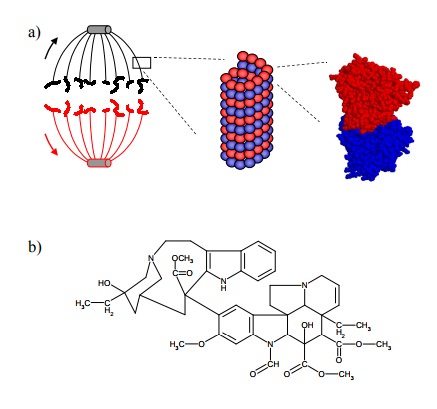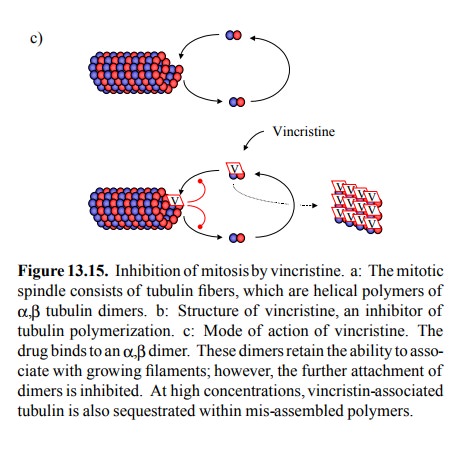Chapter: Biochemical Pharmacology : Some principles of cancer pharmacotherapy
Inhibitors of mitosis
Inhibitors of mitosis
Inhibition of mitosis is
caused by drugs that interfere with the polymerization of tubulin. The polymers
of tubulin consist of α,β dimers, assembled in a helical fashion into a
hollow fiber. These tubules are dynamically being formed and destroyed as
needed by the cell; polymerization is GTP dependent. They are important in
molecular transport and motion; broadly speaking, tubulin is to dynein what
actin is to myosin. However, tubulin-dynein participates in other processes of
molecular motion than actin/myosin, includ-ing the segregation of the
chromosomes in mitosis. The mitotic spindle is the tubulin framework assembled
for this purpose (Figure 13.15a). Formation of the spindle is inhib-ited by
vincristine (Figure 13.15b). This drug molecule has a very nice complex
structure, but I have not found any in-formation on how it actually fits to the
target protein (tubu-lin). In any event, binding of vincristine still permits
the tubulin dimer to associate with the nascent tubule; howev er, it then
inhibits the addition of further subunits. Also, it stays rather firmly in
place, so that the tubule in effect be-comes `capped' and trapped (Figure
13.15c). Monomeric tubulin becoming saturated with vincristine will also
poly-merize into atypical shapes; this, however, seems to be lim-ited to high
drug concentrations and not to occur in vivo. Of note, another drug with
virtually the same mechanism of action is colchicine, which however is used in
the treat-ment of gout rather than cancer. I have not seen any ratio-nal
argument for the preferment of either drug in their re-spective applications.


Finally,
after learning about the modes of action of all these rat poisons, there
remains one nagging question: Why is it that they possess any useful degree of
selectivity for can-cer cells as opposed to healthy body cells at all? Sure,
the side effects of cytotoxic cancer therapy are considerable, most prominently
(and unsurprisingly) affecting the most rapidly proliferating tissues such as
bone marrow and in-testinal mucous membranes. Still, in many cases condi-tions
can be found in which the tumour suffers a much more pronounced setback than
the normal tissues. Several types of tumours, including childhood leukemias and
testi-cle tumours, are nowadays being cured by chemotherapy in the majority of
cases, without severe long-term damage to the rest of the organism (remember
Lance Armstrong?)13. While a high proliferation rate is certainly an
important determinant of sensitivity to cytotoxic agents, it is worth pointing
out that the mitotic rates of most tumours do not come close to the
regeneration rates of the healthy bone marrow – a human being generates a
whopping 600 kg of erythrocytes and leukocytes each during a lifetime!
Related Topics